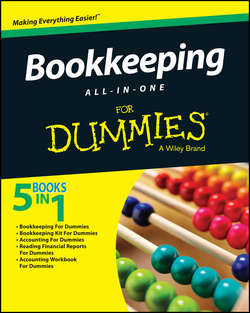Читать книгу Bookkeeping All-In-One For Dummies - Dummies Consumer - Страница 14
На сайте Литреса книга снята с продажи.
Book I
Keeping the Books
Chapter 1
Basic Bookkeeping
Seeing Double with Double-Entry Bookkeeping
ОглавлениеAll businesses, whether they use the cash-basis accounting method or the accrual accounting method, use double-entry bookkeeping to keep their books. A practice that helps minimize errors and increase the chance that your books balance, double-entry bookkeeping gets its name because you enter all transactions twice.
When it comes to double-entry bookkeeping, the key formula for the balance sheet (Assets = Liabilities + Equity) plays a major role.
In order to adjust the balance of accounts in the bookkeeping world, you use a combination of debits and credits. You may think of a debit as a subtraction because you’ve found that debits usually mean a decrease in your bank balance. On the other hand, you’ve probably been excited to find unexpected credits in your bank or credit card that mean more money has been added to the account in your favor. Now, forget all that you ever learned about debits or credits. In the world of bookkeeping, their meanings aren’t so simple.
The only definite thing when it comes to debits and credits in the bookkeeping world is that a debit is on the left side of a transaction and a credit is on the right side of a transaction. Everything beyond that can get very muddled. Don’t worry if you’re finding this concept very difficult to grasp. You get plenty of practice using these concepts throughout this book.
Before getting into all the technical mumbo jumbo of double-entry bookkeeping, here’s an example of the practice in action. Suppose you purchase a new desk that costs $1,500 for your office. This transaction actually has two parts: You spend an asset – cash – to buy another asset – furniture. So, you must adjust two accounts in your company’s books: the Cash account and the Furniture account. Here’s what the transaction looks like in a bookkeeping entry:
In this transaction, you record the accounts impacted by the transaction. The debit increases the value of the Furniture account, and the credit decreases the value of the Cash account. For this transaction, both accounts impacted are asset accounts, so, looking at how the balance sheet is affected, you can see that the only changes are to the asset side of the balance sheet equation:
Assets = Liabilities + Equity
Furniture increase = Cash decreases = No change to total assets
In this case, the books stay in balance because the exact dollar amount that increases the value of your Furniture account decreases the value of your Cash account. At the bottom of any journal entry, you should include a brief explanation that explains the purpose for the entry. The first example indicates this entry was “To purchase a new desk for the office.”
To show you how you record a transaction if it impacts both sides of the balance sheet equation, here’s an example that shows how to record the purchase of inventory. Suppose you purchase $5,000 worth of widgets on credit. (Haven’t you always wondered what widgets were? You won’t find the answer here. They’re just commonly used in accounting examples to represent something that’s purchased.) These new widgets add value to your Inventory Asset account and also add value to your Accounts Payable account. (Remember, the Accounts Payable account is a Liability account where you track bills that need to be paid at some point in the future.) Here’s how the bookkeeping transaction for your widget purchase looks:
Here’s how this transaction affects the balance sheet equation:
Assets = Liabilities + Equity
Inventory increases = Accounts Payable increases = No change
In this case, the books stay in balance because both sides of the equation increase by $5,000.
You can see from the two example transactions how double-entry bookkeeping helps to keep your books in balance – as long as you make sure each entry into the books is balanced. Balancing your entries may look simple here, but sometimes bookkeeping entries can get very complex when more than two accounts are impacted by the transaction. Don’t worry, you don’t have to understand it totally now. You’ll see how to enter transactions throughout the book. Again, this is just a quick overview to introduce the subject.
